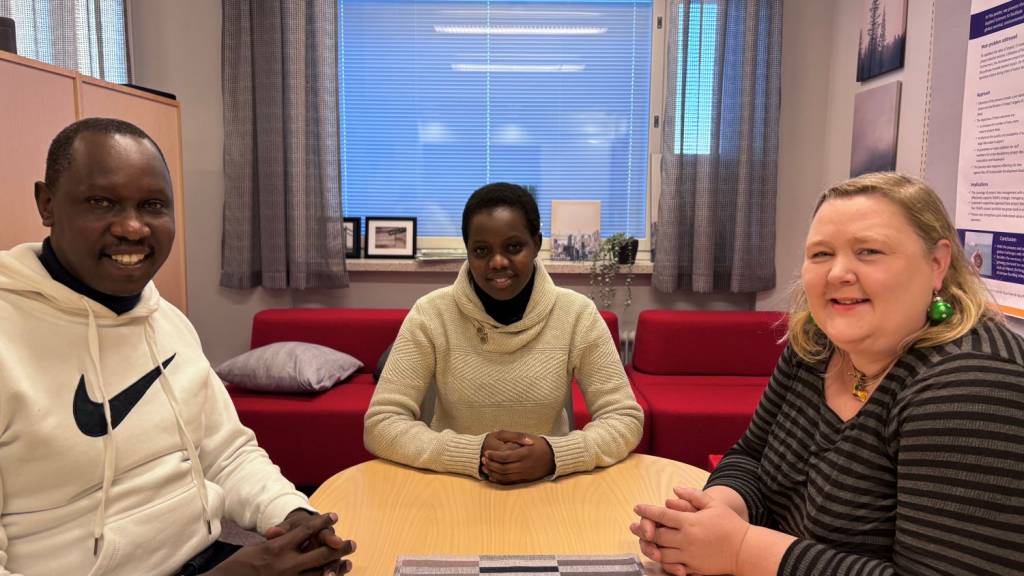Global mobility and cultural understanding
Kenya, situated in East Africa, is a nation of remarkable diversity, home to over 40 ethnic groups, each possessing its language, customs, and traditions. These cultural complexities influence how individuals learn, work, and interact. They shape attitudes towards authority, collaboration, and personal initiative. In contrast, Finland embodies a different cultural framework, where democratic values, self-direction, and collaborative problem-solving are particularly emphasised. As global mobility increases and international partnerships become more prevalent, understanding cultural approaches has gained importance. It is increasingly valuable for students, professionals, and researchers to learn how Kenyans and Finns tackle educational and workplace challenges. TAMK has been collaborating for years with KSUC, fostering a mutual exchange of knowledge and cultural insights to strengthen these connections (Heikkilä & Piiroinen, 2023).
Before delving into specific examples, it is important to acknowledge that the following descriptions of working life and educational approaches are intentional generalizations. They are mentioned to highlight broader cultural phenomena rather than define the experiences of all individuals within Finnish or Kenyan institutions. It is important to acknowledge that cultural tendencies exist but at the same time significant variation can be found within both countries, and personal experiences may differ considerably depending on context and background.
Education systems in Kenya and Finland
Kenya’s education system is shaped by its colonial history, during which British structures introduced teacher-centred methods (Imana, 2020). The teacher is regarded as the primary authority figure in many Kenyan classrooms. They impart knowledge to students who memorise essential content, and often learn by following detailed instructions. This approach fosters a high level of discipline, clarity, and respect for elders but can prioritise less critical thinking and open-ended exploration. Kenyan students typically prepare for exams that assess recall, which may restrict the scope of innovation and creativity. Conversely, emphasising hierarchy and structured guidance can provide a sense of security and stability in learning, fostering consistent study habits.
Finland, frequently praised for its high-quality educational system, embraces a markedly different philosophy (Sahlberg, 2007). Finnish classrooms emphasise self-direction, with teachers acting as facilitators rather than unquestioned authorities. Students engage in hands-on projects, group discussions, and problem-solving activities, encouraging them to explore in-depth topics (Chemutai et al., 2025). This model fosters independence, curiosity, and the ability to challenge general assumptions. Collaboration is deeply ingrained in daily classroom routines, preparing Finnish learners for workplaces that value teamwork, flexibility, and innovation. While this open environment can be highly effective in shaping adaptable, self-reliant graduates, it has limitations. It may occasionally overlook the benefits of direct mentorship or the necessity for more structured oversight in complex areas.
Work cultures in Kenya and Finland
Kenyan workplace culture reflects a blend of hierarchical and clan-based models shaped by the country’s societal values and educational system (Kimemia, 2015). Hierarchical structures, in which management exercises decisive power over strategy and direction, create clear chains of command and ensure stability. This is particularly important in industries requiring meticulous oversight, such as healthcare, construction, and aviation (McCowan, 2018). Complementing this, the clan culture fosters family-like networks, emphasising collaboration and shared values. Together, these models help prevent hasty decisions by leveraging experienced leadership and established protocols. However, this reliance on authority – rooted in hierarchy or clan networks – can sideline younger employees (McCowan, 2018). It may also limit innovation and slow decision-making, particularly in fast-paced or technology-driven fields (Kimemia, 2015). Balancing these traditional strengths with greater adaptability and employee autonomy is crucial for organisations to thrive in a rapidly changing environment.
Kenya’s respect for senior authority contributes to stability and precision, an asset when long-term commitment and caution are priorities.
Finnish workplaces are typically characterised by flat, decentralised structures that broadly distribute decision-making authority across all levels of the organisation (Niemelä & Kalliola, 2007). Employees are trusted to identify problems, propose solutions, and implement improvements without constant oversight from senior managers. This approach reflects a societal emphasis on equality and individual responsibility. This proactive and autonomous approach fosters agility. It enables teams to iterate quickly, pivot, and develop innovative ideas, particularly in startups or research-based organisations (Hornung & Rousseau, 2007). Rapid cycles of testing and learning enhance competitiveness in fields such as software development and creative industries. However, such openness can sometimes lead to gaps in strategy when decisions are made without the input of experienced senior professionals who could provide a more comprehensive perspective. Effective communication systems are essential to maintain consistent quality and alignment with overarching goals. They ensure that individual autonomy is balanced with input from seasoned leaders who can guide day-to-day tasks while reinforcing a shared strategic vision.
Kenya’s respect for senior authority contributes to stability and precision, an asset when long-term commitment and caution are priorities. Finland’s emphasis on decentralised methods fosters speed, creative thinking, and the freedom to experiment. When viewed together, these approaches are not adversaries but complementary facets of organisational success. Kenyan institutions can selectively adopt frameworks that grant more autonomy to mid-level managers or specialised teams. This approach empowers them to take the initiative on time-sensitive decisions, while senior leaders oversee strategic direction. This enables quicker responses without undermining the trusted hierarchy that has proven valuable in many sectors. Conversely, Finnish institutions could adopt structured processes for major projects to include expert counsel in high-risk initiatives.
Practical approaches to cross-cultural cooperation: workshops, exchanges, and collaborative tools
Small-scale pilot projects, workshops, seminars, and structured training involving Kenyans and Finns can enhance cross-cultural awareness. These initiatives enable both sides to appreciate the strengths that each approach contributes. Developing cultural competence through these interactions allows participants to navigate differences more effectively and align their practices with shared objectives. Immersive experiences such as student exchanges and internships further illustrate how deeply educational backgrounds influence professional habits and expectations. These encounters broaden personal perspectives, cultivate cultural empathy, and enhance cultural competence. They underscore the significance of communication in bridging differences.

Photo 1 Kenyan teacher trainees Faith Chemutai and Josephat Kiplimo Tum in conversation with Tampere University of Applied Sciences International Planning Officer Krista Merikoski (Photo: Ilkka Piiroinen)
Building bridges between cultures benefits considerably from thorough preparation and practical tools. For example, coordinators from both nations can collaboratively design and test evaluation tools tailored to cultural matters (Lombardi, 2010). They can also develop a comprehensive risk mitigation plan and create pre-departure orientation packages (Kalbarczyk et al., 2019). These tools facilitate smoother interactions and foster mutual cultural understanding. Proactive measures help participants anticipate potential challenges, establish clear communication practices, and align expectations. By investing in structured preparation, institutions create an environment where individuals feel supported and empowered to navigate cross-cultural dynamics confidently.
The networks can refine best practices that cater to industries ranging from traditional manufacturing to cutting-edge digital services.
International collaborations gain from technology that facilitates consistent interaction among geographically distant teams. This makes sharing updates, seeking feedback, and holding virtual meetings easier. Over the long term, sustained connections between Kenyan and Finnish universities, companies, and non-profit organisations can lead to more integrated practices. These connections foster a new generation of managers, entrepreneurs, and educators who combine structured oversight with open-ended exploration. By building on shared experiences, these networks can refine best practices that cater to industries ranging from traditional manufacturing to cutting-edge digital services.
Balancing hierarchy with autonomy in cross-cultural cooperation
Kenya and Finland exemplify how culture shapes education, workplace structures, and decision-making processes. Kenya’s teacher-centred methods foster discipline and respect for authority, shaping professional norms that prioritise clear leadership and careful planning. Finland’s self-directed approach to education nurtures independence and creative thinking. This is reflected in workplaces where employees share responsibilities and collaboratively shape solutions. Far from being mutually exclusive, these models contain valuable insights that organisations seeking to thrive in an interconnected world can adopt or adapt. Kenyan and Finnish institutions can enhance innovation by experimenting with hierarchical and decentralised elements. This approach helps them remain responsive to emerging challenges while respecting the cultural values that anchor them. Ongoing dialogue, exchange programmes, and pilot initiatives can unite these cultures, blending stability, creativity, and a shared purpose.
References
Chemutai, F., Kiplimo Tum, J., Heikkilä, E. & Piiroinen, I. 2025. Kenya’s educational reform: leveraging Proakatemia team learning model. TAMKjournal 15.1.2025. Read on 18.1.2025 https://sites.tuni.fi/tamk-pub/tamkjournal/kenyas-educational-reform-leveraging-proakatemia-team-learning-model-faith-chemutai-josephat-kiplimo-tum-eeva-heikkila-and-ilkka-piiroinen/
Heikkilä, E. & Piiroinen, I. 2023. Kohtaa kulttuurit, rakenna luottamus: Suomi–Kenia-yhteistyö urheilukasvatuksessa. 2023. TAMK-blog. 27.12.2023. Read on 18.1.2025. https://blogs.tuni.fi/tamkblogi/hanketoiminta/kohtaa-kulttuurit-rakenna-luottamus-suomi-kenia-yhteistyo-urheilukasvatuksessa/
Hornung, S., & Rousseau, D. M. 2007. Active on the Job – Proactive in Change: How Autonomy at Work Contributes to Employee Support for Organizational Change. The Journal of Applied Behavioral Science, 43(4), 401-426. https://doi.org/10.1177/0021886307307555
Imana, D. K. 2020. The politics of education reforms in Kenya: Critical assessment of the education system from 1963-2020. Journal of Community Positive Practices, (2), 11-30. https://doi.org/10.35782/JCPP.2020.2.02
Kalbarczyk, A., Nagourney, E., Martin, N.A., Hansoti, B. 2019. Are you ready? A systematic review of pre-departure resources for global health electives. BMC Medical Education, 19, 166. https://doi.org/10.1186/s12909-019-1586-y
Kimemia, D. 2015. The organizational culture of non-governmental organizations in Kenya. Organizational Cultures: An International Journal, 13(4), 15–30. https://doi.org/10.18848/2327-8013/CGP/v13i04/50942
Lombardi, M. R. 2010. Assessing intercultural competence: A review. NCSSSMST Journal, 16(1), 15-17. Read on 25.1.2025. https://files.eric.ed.gov/fulltext/EJ930654.pdf
McCowan, T. 2018. Quality of higher education in Kenya: Addressing the conundrum. International Journal of Educational Development, 60, 128–137. https://doi.org/10.1016/j.ijedudev.2017.11.002
Niemelä, J., & Kalliola, S. 2007. Team Membership and Experiences of Work in the Finnish Context. Economic and Industrial Democracy, 28(4), 552-588. https://doi.org/10.1177/0143831X07082196
Sahlberg, P. 2007. Education policies for raising student learning: the Finnish approach. Journal of Education Policy, 22(2), 147–171. https://doi.org/10.1080/02680930601158919
Authors
Josephat Kiplimo Tum
Master of Education student majoring in Educational Administration at Koitaleel Samoei University College (Kenya). Josphat is in his second year of Master’s Degree studies, with an expected graduation in 2025. His focus lies in Educational Administration, and he plans to continue his academic journey by pursuing a PhD in Research, Development, and Innovation within the same field.
Faith Chemutai
Master of Education student majoring in Curriculum Studies at Koitaleel Samoei University College (Kenya). Faith is in her second year of Master’s Degree studies, and expects to graduate in 2025. Her studies focus on Curriculum Studies, and she intends to pursue a PhD in the same field, further deepening her expertise and academic contributions.
Ilkka Piiroinen
Senior Lecturer at the Social and Health Care Unit of Expertise. Ilkka holds a PhD in epidemiological research, focusing on the connection between orientation to life and mortality. As a lecturer, he teaches anatomy of the musculoskeletal system, physiotherapy, pain-related topics, and health sector entrepreneurship. He also supervises bachelor’s and master’s theses and participates in various projects.
Eeva Heikkilä
RDI Specialist at Tampere University of Applied Sciences. Eeva specialises in implementing high-quality national and international projects, ensuring alignment with TAMK’s strategic goals and desired outcomes. Her expertise includes project implementation, RDI development, and building domestic and global networks. She is particularly active in Erasmus+, Interreg, and mobility projects.
Photo: Pixabay

